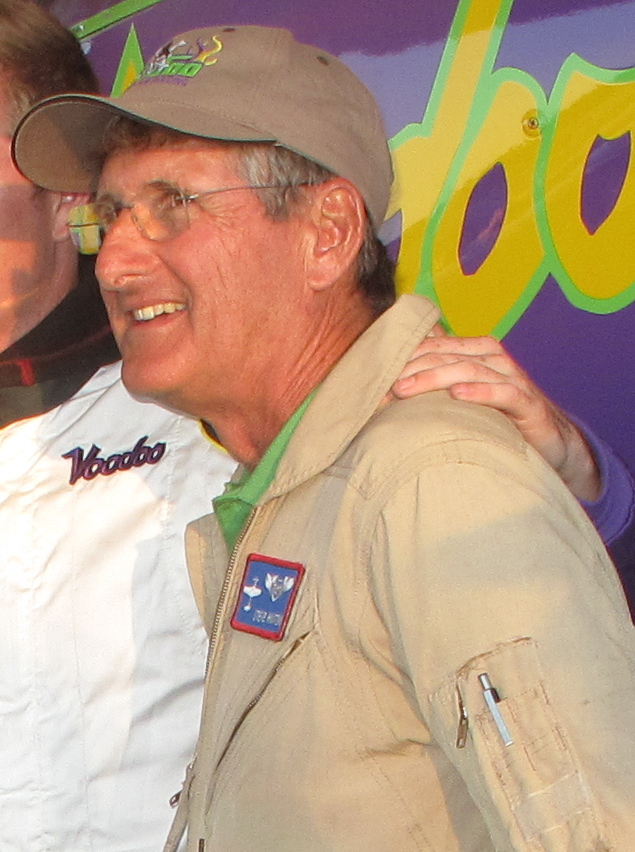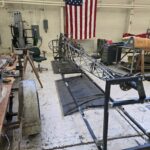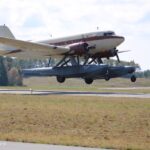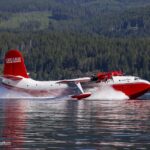By Noah Stegman Rechtin
Aviation museums are such cool places, it’s only natural that many people want to work at them. If this is your goal, there are a number of things you need to know about how to pursue it. Before getting started, there is one clarification that is necessary: This is not an article about how to volunteer at an aviation museum, as that is quite easy. Instead, it is about how to become an employee. However, as volunteering is very often a prerequisite, it will be frequently touched on. The first and most important thing is to decide what you want to do. It will determine everything else about how you proceed – from what type of education you will need to which museums you are going to apply to. Specifically, do you want to be a pilot, a mechanic, or a curator?

I can’t speak from personal experience to what is sought in a pilot or a mechanic because I am neither of those things. However, I have spoken with them and seen several brought onboard at our museum. The number one piece of advice I have heard them give is to simply get involved in aviation. Many of them started washing planes or running errands at their local general aviation airport. The pilots and mechanics would take notice of their enthusiasm and, when the workday was done, say, “hey, kid, wanna go for a ride?”
It’s actually even easier when it comes to museums because they are always looking for volunteers. As previously stated, I am not a pilot, but I have been incredibly privileged to be able to ride in some amazing aircraft because I was simply standing around when an airplane had to be tested or a pilot needed to practice and they had an empty seat. The dedication is not just about being available when an opportunity happens to arise, it’s also about people getting to know you better. I have been told that earning the proper licenses, ratings, and endorsements to fly a P-51 is the easy part. Finding someone who will let you fly it is much harder. There is good reason for this. Historic aircraft are expensive, high performance pieces of equipment, and their owners are justifiably protective of them. To put it another way, you wouldn’t toss the keys of your Ferrari to just anyone. Owners want to make sure that pilots, frankly, won’t do anything stupid with them, and so they only hand over the metaphorical “keys” to someone they trust. Showing up at the museum and asking to fly an airplane on your first day will immediately turn them off. Instead, when the time comes and someone gets promoted or retires and museum management has to find a replacement, they will look around and say, “who has consistently been around?”
Mechanic
Similarly, when it comes to flying museums, if you want to be a mechanic don’t necessarily expect to come in and immediately work on airplanes. Museums with static display aircraft will very frequently allow volunteers to help restore them. However, the potentially catastrophic consequences of a bolt not being tightened or an instrument not being calibrated means that when it comes to airworthy aircraft, the people allowed to work on them is a lot more restricted. While technically anyone is allowed to “wrench” on an airworthy aircraft as long as they are supervised by an A&P, many museums will only allow individuals with some level of prior experience work on their aircraft. A formal education in aviation maintenance involves earning a certain type of Federal Aviation Administration certification called an “aviation and powerplant” – the A&P mentioned above. Your local technical or vocational school will probably have a program.

As a curator I can say that the number one thing I would look for in a candidate is someone who can think critically. The honest truth is that I have seen no shortage of “history buffs” who can rattle off facts and figures about aircraft walk through the front door of the museum. If that was all that was needed, I would have very little problem finding someone to fill a position. However, being a true “historian” (or curator) requires the ability to make arguments, evaluate evidence, and see the bigger picture. Someone who can tell me not only how fast a P-51 flies, and not even only why it’s ability to escort bombers all the way from England to Berlin and back was critical, but also how the development of air power doctrine within the U.S. military and the concept of “the bomber will always get through” led to that need. In terms of specific educational requirements, this would translate into someone who has taken the 300-level college class in “historical thought and methods” that comes with a bachelors degree in history. The most prestigious museums will likely require a masters or even a doctorate.
Working as a curator also requires a certain mindset. You need the ability to work methodically and carefully. For instance, any good museum has a set of rules called a collections management policy that lays out how artifacts are to be treated. A good curator understands the nuances of this policy and how they apply when it comes time to make decisions regarding what to deaccession. At the largest museums – such as the National Air and Space Museum or Museum of Flight – the staff is large enough that they can specialize. For example, curators focus on developing exhibits and another role, the collections manager, will actually be in charge of handling the artifacts. However, most aviation museums cannot afford a large number of employees and as a result the staff wear multiple hats. Developing and demonstrating competency in other related areas such as acting as a docent, running the front desk, and managing volunteers will make you a more attractive candidate. By the same token, these types of academic jobs are also rare. There are not many positions available and so it may be some time before one becomes available. Taking a different role is a good way to stay involved until one comes along.
The equivalent of “volunteering” when it comes to higher education is an internship. College programs often offer internships as “on the job training” as part of coursework, and if you’re lucky one of these opportunities will be at an aviation museum. It may be that when your internship is complete, the museum will be looking to fill a position and you can transition to become an actual employee.
Thirdly, for this same financial reason, do not expect to get rich working for an aviation museum (or any museum for that matter). It is a job that people take on because they are passionate about the subject matter. Furthermore, be warned: having a strong investment in the subject matter means that if things don’t go the way you believe is best – an artifact is deaccessioned or the text of an exhibit is rewritten – it can weigh on you. This is not to discourage anyone from the profession, there is much truth in the statement that “if you pick a job you love, you’ll never work a day in your life.” Working at an aviation museum can be very rewarding. However, it is also far from perfect and just like any other job can have downsides.
Examples
Perhaps the best way to learn about the options available is to read what others have done. To that end, below is a list of biographical sketches and interviews with professionals in the field talking about how they got where they are:
- Some came from a military background:
- Jim Haff at the Dakota Territory Air Museum
- Mike Rowland at the Museum of Aviation
- Robert R. Macon at the National Naval Aviation Museum
- Those who chose an academic route include:
- Lech Lebiedowski at the Alberta Aviation Museum
- Erin Gregory at the Canada Aviation and Space Museum
- Robert Welch, Jr. at the Frontiers of Flight Museum
- Justin Hall at the Hill Aerospace Museum
- Landon Wilkey at Historic Wendover Airfield
- Ami Eckard-Lee at the Kelch Aviation Museum
- Sterling Jenson at the March Field Aviation Museum
- Arthur Sullivan at the Museum of Aviation
- Jenn Parent (1, 2) at the Museum of Flight
- Roberta Carothers at the National Museum of the United States Air Force
- Jeff Duford at the National Museum of the United States Air Force
- Casey Simmons at the National Museum of the United States Air Force
- Dina G. Linn of the National Naval Aviation Museum
- Nick Hurley at the New England Air Museum
- Erin Kirchner at the Pioneer Air Museum
- Many have worked their way up from volunteer:
- Debbie Sellars at the Air Mobility Command Museum
- John Liddle at the Alberta Aviation Museum
- Larry Gregory at the Lone Star Flight Museum
- Matthew Hayes at the Museum of Flight
- Ken Emery at the Museum of Aviation
- Bill Paul at the Museum of Aviation
- Chris Reddersen (1, 2) at the National Air and Space Museum
- Sam Winefordner at the Stonehenge Air Museum
- Ron Ferniuk at the Texas Air and Space Museum
While most of the above represent curators, collections managers, archivists or other more traditional museum type roles, there are examples of pilots and mechanics. The former includes Sam Worthington-Leese at the Aircraft Restoration Company and Austin Hancock at the National Warplane Museum and the latter Jim Dale (Part 1, Part 2) of Lewis Air Legends and Luke Jones at the National Air and Space Museum. The video below is a discussion with Ryan Szmanski of the Battleship New Jersey Museum and Memorial, and although he works with a warships and not warbirds, it is an excellent video explaining his career path that is still very applicable to aviation museums. Lastly, to return to the initial point about the importance of picking your path, keep in mind that just as a museum with only static display aircraft has no need for a pilot, the reverse is true for curators at those with airworthy aircraft. Make sure you find a museum with the same priorities as you.
Military
There’s one additional possibility to consider and that’s the military. It’s not well known, but in addition to the National Museum in Dayton, the United States Air Force operates a network of 16 field museums and heritage centers across the country that collectively employ approximately 75 people. On top of that, the Army and Navy operate the National Naval Aviation Museum and United States Army Aviation Museum, respectively. While government run museums do not fly their aircraft – so piloting experience is not specifically necessary – simply being in the military can help you get your foot in the door at one of these locations.
Conclusion
The best advice I can offer is to get involved. I can pretty much guarantee that everyone at your nearest aviation museum has a passion for the subject and when they see someone who shares that passion, they will be more than happy to help them along as best they can. No less than the legendary curator of the National Air and Space Museum, Paul Garber, got his job after pointing out an incorrectly rigged airplane. So, if you want to be a pilot or a mechanic or a curator, but the only volunteer availability at your local museum is for a docent, don’t turn it down because it isn’t what you want. Take it. Eventually, there will be openings to do a little more of the work you’re interested in. That’s your pathway to a career.


























